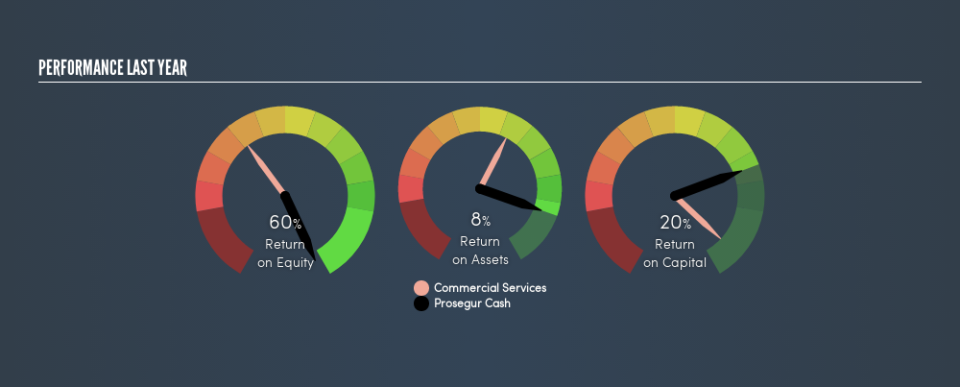Prosegur Cash, S.A. (BME:CASH) Is Employing Capital Very Effectively

Today we are going to look at Prosegur Cash, S.A. (BME:CASH) to see whether it might be an attractive investment prospect. In particular, we'll consider its Return On Capital Employed (ROCE), as that can give us insight into how profitably the company is able to employ capital in its business.
Firstly, we'll go over how we calculate ROCE. Then we'll compare its ROCE to similar companies. Then we'll determine how its current liabilities are affecting its ROCE.
What is Return On Capital Employed (ROCE)?
ROCE measures the amount of pre-tax profits a company can generate from the capital employed in its business. All else being equal, a better business will have a higher ROCE. Overall, it is a valuable metric that has its flaws. Renowned investment researcher Michael Mauboussin has suggested that a high ROCE can indicate that 'one dollar invested in the company generates value of more than one dollar'.
So, How Do We Calculate ROCE?
Analysts use this formula to calculate return on capital employed:
Return on Capital Employed = Earnings Before Interest and Tax (EBIT) ÷ (Total Assets - Current Liabilities)
Or for Prosegur Cash:
0.20 = €244m ÷ (€1.8b - €634m) (Based on the trailing twelve months to March 2019.)
Therefore, Prosegur Cash has an ROCE of 20%.
View our latest analysis for Prosegur Cash
Is Prosegur Cash's ROCE Good?
ROCE can be useful when making comparisons, such as between similar companies. Using our data, we find that Prosegur Cash's ROCE is meaningfully better than the 9.6% average in the Commercial Services industry. We would consider this a positive, as it suggests it is using capital more effectively than other similar companies. Setting aside the comparison to its industry for a moment, Prosegur Cash's ROCE in absolute terms currently looks quite high.
Prosegur Cash's current ROCE of 20% is lower than its ROCE in the past, which was 28%, 3 years ago. This makes us wonder if the business is facing new challenges. The image below shows how Prosegur Cash's ROCE compares to its industry, and you can click it to see more detail on its past growth.
When considering this metric, keep in mind that it is backwards looking, and not necessarily predictive. ROCE can be misleading for companies in cyclical industries, with returns looking impressive during the boom times, but very weak during the busts. ROCE is, after all, simply a snap shot of a single year. What happens in the future is pretty important for investors, so we have prepared a free report on analyst forecasts for Prosegur Cash.
Do Prosegur Cash's Current Liabilities Skew Its ROCE?
Current liabilities are short term bills and invoices that need to be paid in 12 months or less. Due to the way ROCE is calculated, a high level of current liabilities makes a company look as though it has less capital employed, and thus can (sometimes unfairly) boost the ROCE. To counter this, investors can check if a company has high current liabilities relative to total assets.
Prosegur Cash has total liabilities of €634m and total assets of €1.8b. Therefore its current liabilities are equivalent to approximately 35% of its total assets. Prosegur Cash has a medium level of current liabilities, boosting its ROCE somewhat.
The Bottom Line On Prosegur Cash's ROCE
Despite this, it reports a high ROCE, and may be worth investigating further. Prosegur Cash looks strong on this analysis, but there are plenty of other companies that could be a good opportunity . Here is a free list of companies growing earnings rapidly.
If you are like me, then you will not want to miss this free list of growing companies that insiders are buying.
We aim to bring you long-term focused research analysis driven by fundamental data. Note that our analysis may not factor in the latest price-sensitive company announcements or qualitative material.
If you spot an error that warrants correction, please contact the editor at editorial-team@simplywallst.com. This article by Simply Wall St is general in nature. It does not constitute a recommendation to buy or sell any stock, and does not take account of your objectives, or your financial situation. Simply Wall St has no position in the stocks mentioned. Thank you for reading.

